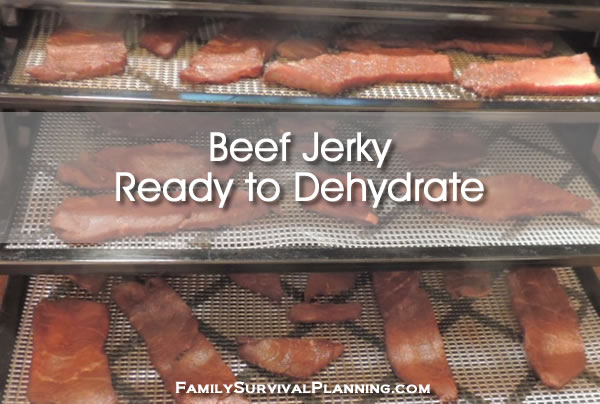- HOME
- Preserving Food
- Homemade Jerky
Make Your Own Jerky At Home

I did it! I finally got up the nerve to try making my own beef jerky.
Why did I decide to try it? Two reasons: 1) It's quite expensive in the stores, and 2) store-bought may contain bht, sodium nitrates or msg. (Note: Soy sauce contains sodium benzoate, which is a preservative, but is not a nitrate.)
Invest in emergency food storage now and enjoy peace of mind for the next 25 years. Don't miss out on the savings!
Step 1: What kind of meat?
First, I went shopping for a lean steak. It is advisable to use the leanest piece of meat you can find, according to my Excalibur dehydrator recipe book. I chose about a 3-pound London Broil. Remove any fat to avoid the possibility of rancidity.
Then, as instructed, I put it into the freezer for a couple of hours to partially freeze it. This makes slicing it much easier because the slices need to be about 1/6-1/8 of an inch and as uniform as possible. I would love to have a meat slicer but have not yet found one that is affordable and not a commercial type (very expensive).
Slicing Tips:
Slightly frozen meat makes slicing before drying much easier.
For tougher jerky, slice the meat with the grain.
For tender jerky, slice across the grain
Step 2: Marinating
After slicing, I put the pieces into a large Ziploc bag with a homemade teriyaki sauce.
This is the marinade recipe I used:
Teriyaki Marinade
- 3 pounds of lean meat (beef, port or venison)
- 1 cup Soy Sauce (I use the 'light' soy sauce - less salt.)
- 2 tablespoons Worcestershire Sauce
- 2 tablespoons brown sugar
- 1/4 teaspoon garlic powder
- 1 teaspoon onion powder
- 1/2 teaspoon cayenne pepper
- 2 ounces Liquid Smoke
- 2 ounces dark corn syrup or molasses for even more flavor (I used molasses)
Directions:
- In a small bowl, combine all ingredients (except meat). Mix well.
- Place meat in a large Ziploc bag.
- Pour marinade over all.
- Squeeze out most of the air and close tightly.
- Marinate 12 to 24 hours in the refrigerator, turning bag often.
Don't be afraid to experiment with other recipes and combinations, such as a dark beer (yes, beer), honey, lime, peppers of your choice, pineapple juice, ginger, or curry powder.
Step 3: The Dehydrating Process
Shake off any excess marinade and spread the meat strips in a single layer on the dehydrator trays. Dry at 155 degrees F/68 degrees C for approximately 4-6 hours, occasionally blotting off any fat droplets that appear on the surface.
While drying, the temperature will go up and down around the set point - this is important to dry correctly. The meat will hit 160 degrees if the dehydrator is set at 155. (This only applies to the Excalibur as far as I know.)

Step 4: How to Store Jerky
Short-term Storage
Since this jerky doesn't last long around our house, I like to put several pieces in Ziploc sandwich baggies and throw them in the freezer for my husband's lunches. They will last a few weeks or up to a month in the refrigerator.
Long-term Storage
- Vacuum Sealed: Jerky will store well if packaged in an air-tight container. Use oxygen absorbers if the container can be sealed, or vacuum pack in appropriate bags or canning jars.
- Dry Canning: Dry canning in mason jars will preserve your beef jerky for a longer time. Here's how to dry can:
- Set oven to 350 degrees F.
- Put empty bottles in the oven for about 10 minutes along with the lids on a cookie sheet.
- Remove jars (use mitts!) and quickly fill with jerky strips.
- Screw on the rings and lids and let them cool to room temperature. They will seal as they cool (listen for the "ping").
- Freezer: Freezing your jerky will preserve them for 6 to 12 months if vacuum packed. I like the FoodSaver vacuum seal bags because they are made of a more durable material and vacuum sealing prevents freezer burn.
Store in a cool, dark, dry place. If beads of moisture form on the inside of the storage container, the jerky is not dry enough and could mold. Either dry longer or store in the freezer.
Be Creative — Vary the Types of Meat
- Beef Jerky - Flank (London Broil), top round, and sirloin tip cuts are the best for making jerky because they are quite lean.
- Game Jerky - deer, bear, and elk meat can be made into jerky. Venison makes excellent jerky because it has no marbled fat. Flank or round cuts are best. Before drying, game meat should be frozen for 60 days at 0 degrees. This should kill any disease-causing bacteria that may be present.
- Poultry Jerky - For this kind of jerky, use the same cures as for beef. Since poultry is quite fibrous, expect your jerky to be somewhat more brittle than beef. Dry at 155 degrees F until dehydrated throughout (about 4 hours).
- Fish Jerky - Dehydrating fish is not a process to be taken lightly. The fish MUST be extremely fresh to prevent spoilage before it can be dried. Stay away from fatty or oily fish like tuna as it spoils rapidly. And, unlike beef, there is no way to simply cut off the fat. It's best to follow the instructions that came with your dehydrator or find a good recipe with explicit directions.
Best fish to use for jerky:
- Cod
- Flounder
- Croaker
- Grouper
- Haddock
- Halibut
- Monkfish
- Ocean Perch
- Pollock
- Rockfish
- Sea Bass
- Sea Herring
- Shrimp
- Smelt
- Snapper
- Sole
- Whiting
- Yellow Perch
I hope you decide to try jerky. I bet you will find it just as easy as I did. My husband loves jerky — he loves to snack on it throughout the day at work. The only problem with homemade jerky is that his co-workers are always begging him for "just a little piece". It's THAT much better than store-bought!














